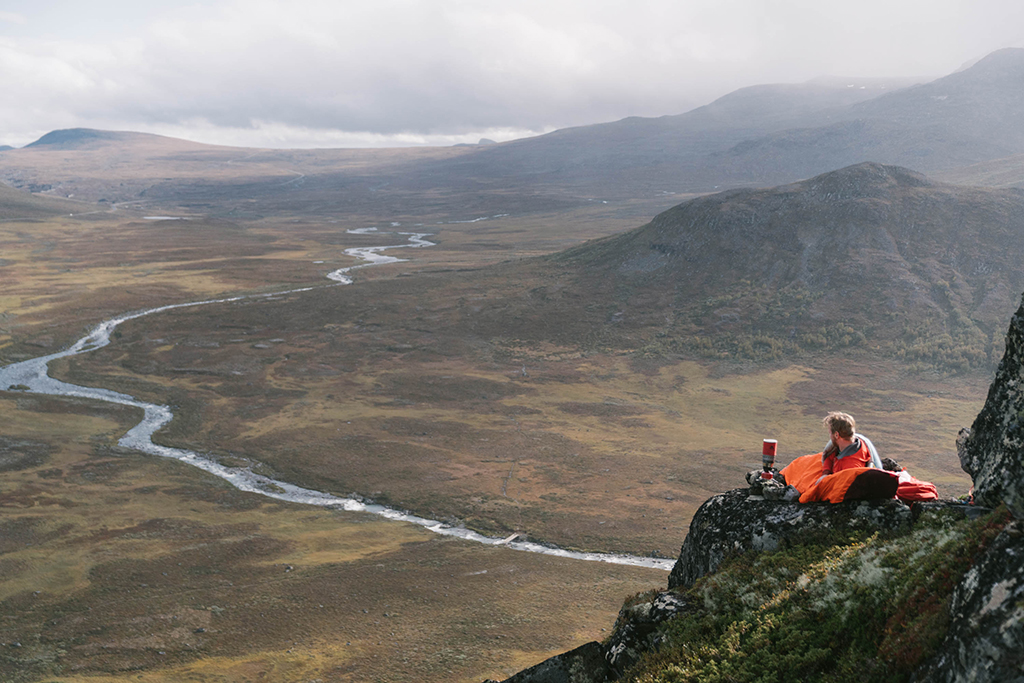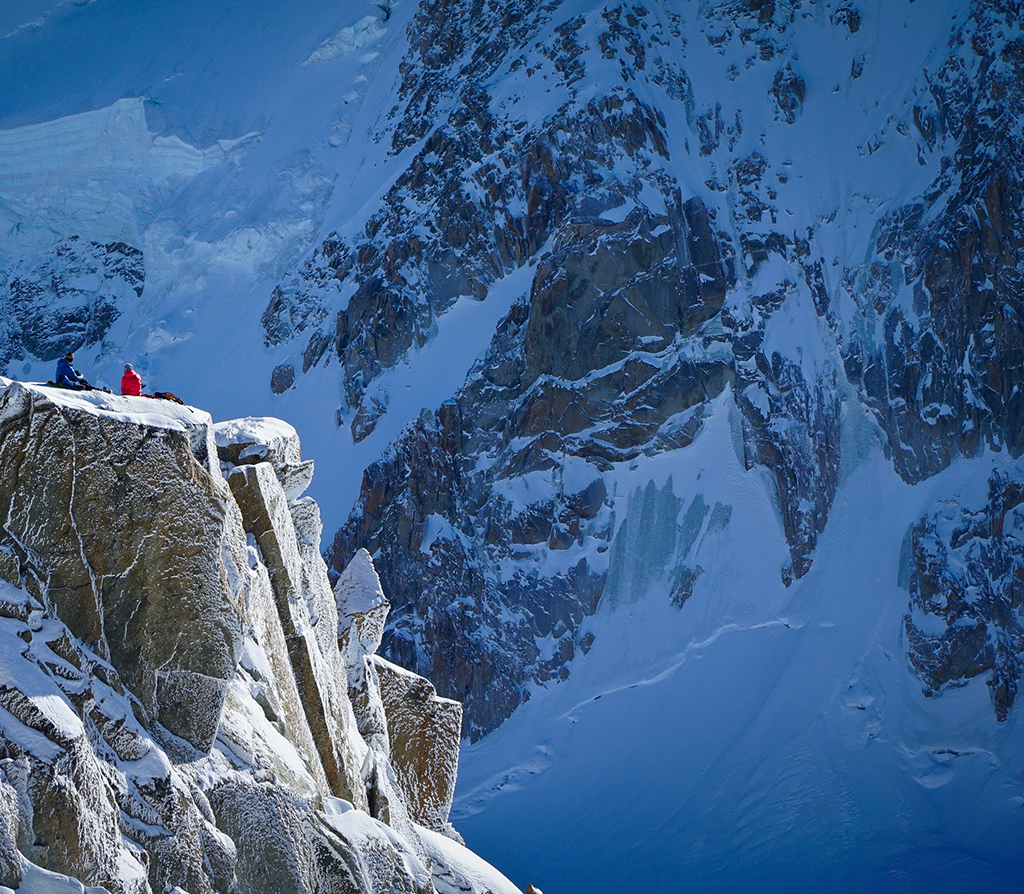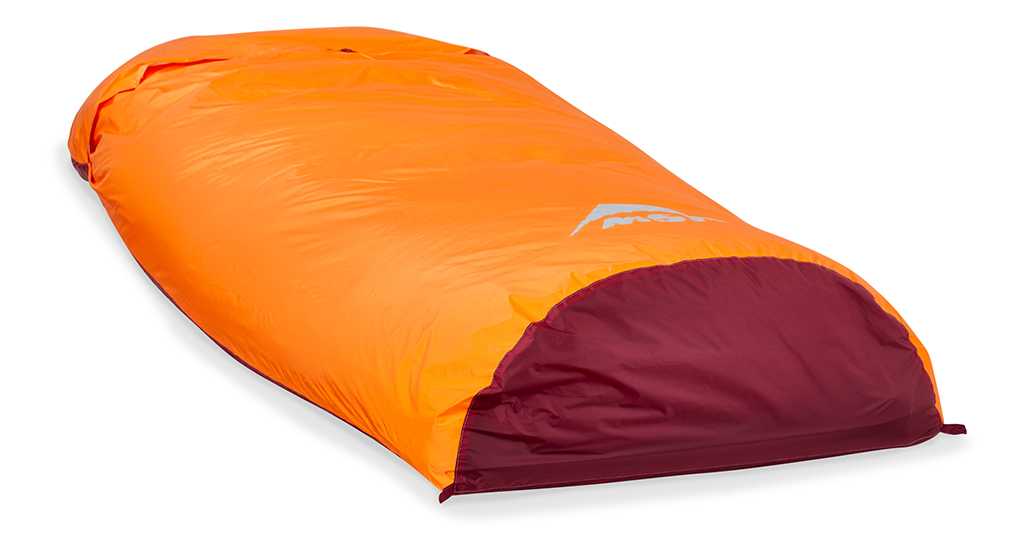Can You Repair A Bivy Sack
It'due south truthful… The bivouac sack (or "bivy" sack) is merely a weatherproof encompass for your sleeping bag with a breathing hole—the perfect bear burrito, filled with your ambitions to complete those ultralight objectives.
Some phone call bivies "cramped." Others telephone call them "miserable nights" spent in the harsh wilderness, when the machine is far beyond your physical and mental fortitude. To many, they're simply insurance against unplanned nights in the hills, ideally never to be used.
But the devout know better: Indeed, there's an elegant and sophisticated simplicity to the bivy sack.

When used under the right conditions, a bivy sack is central to mastering the fine art of fast and light travel on large backcountry missions.
First, what is a bivy sack?
Bivy sacks are unmarried-person, minimalist shelters that offering an boosted layer of protection against the environs for you and your sleeping bag—retrieve cowboy camping with a total-torso trounce.
Just larger than your sleeping bag and mattress, bivies are typically synthetic of waterproof or h2o-resistant materials to shield against current of air and precipitation.
Originally adult as emergency shelters, today bivy sacks and bivy shelters come in a range of styles. Traditional, ultra-simple bivy numberless—like MSR'southward Pro Bivy and Eastward-Bivy—weigh much less than a one-person tent and offer a utilitarian approach for traveling as light as possible.
On the other end of the spectrum, full-featured bivy shelters add a pound or and so more to your pack, but include an internal pole for expanded headspace and full-length zippers, offering a small-tent-like feel.

Who is the bivy adventurer?
The choice to bivy is one of priorities and goals.
Adventurers moving fast with low-volume packs choose this supremely efficient shelter for the freedom to travel unencumbered. These adventurers are driven to trade the comfort of a tent for the luxury of a lighter, smaller load on their backs or in their haul bags. Their mindset is on successfully completing an objective, rather than lounging at camp.
Traditionally, alpine and large-wall climbers relied on bivy sacks for hunkering down during multi-dark objectives in technical terrain, where sleeping ledges are too cramped for a tent.
But these days, bikepackers, fastpackers, thru-hikers, and minimalist solo adventurers choose bivies to shed every possible gram while maintaining an element of weather protection.

Why choose a bivy sack over a tent?
Nether the right conditions, bivies equal freedom. They enhance your connection to the outside world and they demand a true adherence to the minimalist mindset, which is an achievement all its own. Hither'due south why a bivy may be your ultimate ally on big mount endeavors.
Less weight
The most pared-downwardly of bivies weigh just a few grams. MSR's Pro Bivy, engineered to run across the needs of professional alpinists and serious adventurers, weighs simply 283 g (10 oz). Even lighter still, MSR's Due east-Bivy weighs a mere 170 grams (6 oz.), perfect for tossing in a pack lid as an emergency shelter on everything from all-day hikes to backcountry ski tours.
Packability
The ultra-compact nature of bivies makes them a valuable assets when shedding weight. Some stuff downwardly to the size of a burrito (the food kind), disappearing in bikepacking bags and small alpine packs. With a smaller pack you tin can encompass more than miles and more easily traverse through technical terrain.
Sleeping spaces
And technical terrain is where the bivy shines. Requiring only the length and width of your slumber organisation, bivies open up upwards campsite possibilities. Stone ledges, climbers' nooks on craggy scrambles, snow caves and narrow backcountry spaces too tight for staking out a tent all become bachelor real estate for a night under the stars.
Warmth
Similar a lite rainshell jacket, bivies trap in a few degrees of warmth and hold that heat better than a tent; this takes an open up night on the footing upward a notch, allowing y'all to gain the rest y'all need. MSR's bivies characteristic a water-resistant, breathable ripstop nylon for the tiptop layer to reduce condensation and keep you drier and more comfortable inside. Past their nature, bivies are far more enjoyable when the weather condition is fair—well-nigh will offer little protection in a nasty Cascades or Rockies storm blitz. But during loftier-pressure systems in the shoulder seasons or on summer tall traverses, bivies add an extra layer of warmth to minimalist nights beneath the peaks.
Pairing a bivy with a tarp expands your forecast options while keeping weight often below or similar to a one-person tent, and gives you the flexibility to have both or only 1 component depending on the trip.
Efficiency
No setup. No pitching. No hassle. With nothing to assemble after a long 24-hour interval, nor to break down the side by side morning, bivies get you back on your route faster. All that time and free energy saved may be devoted to the solar day ahead. Additionally, these ultralight shelters offer an exceptional weight-to-protection ratio and efficiency.
Immersion in your environs
While tents cut off your sense of place when you're inside, bivy camping—out in the open, with the enormousness of the mountains surrounding you—is an feel all its ain. The peaks of the Picket Range or the scarlet rocks of the southwest feel closer, larger and more rugged when you have an immersive, front-row view.

The Art of the Bivy: 14 Tips for a Comfortable Bivouac
Interested in bivy camping ground on your next adventure? Follow these tips for an optimal feel.
- Observe a sheltered zone or nook; frequently popular climbs will feature bivy sites surrounded past rock walls.
- Ensure you lot're not setting downwards in small h2o channel (pay attention to the contours effectually y'all).
- Place the gear you need kept warm at the foot of your sleeping pocketbook.
- Alter out of wet layers before bed.
- On cold nights, place a Nalgene® canteen of hot h2o in a core zone—crotch or arm pits—for instant warmth.
- Just like camping in a tent, cook a good distance away from your sleeping site.
- Cinch the bivy's hood downward around your face, just avoid breathing within the bivy which tin can create condensation.
- A buff or balaclava makes a groovy lightweight face mask.
- If possible, during the day turn the bivy inside out and air information technology out.
- In snowfall, consider using an ultralight tarp underneath and two sleeping pads—a closed-cell pad and an air pad—for greater insulation from the ground. Run across these tips for snow camping.
- Because the bulk of your gear won't be protected, consider a haversack liner/embrace to guard against precip.
- Consider choosing a h2o-resistant sleeping bag as actress insurance.
- Employ these tips to merchandise the austere bivy experience for one with a piffling luxury.
- Check the forecast! And savor the lighter pack on your back.
Other factors to consider
Like other types of fast and light equipment, bivies are specialized pieces of gear. Every bit nifty enablers of big pursuits, they require you to set your priorities. Any features added to to the bivy sack to combat a greater range of environments also add weight. When choosing whether a bivy is right for your adventure, consider the bear upon of factors like condensation, bugs, the restrictive space, and the forecast. Determining the types of adventures you lot wish to tackle—fast overnights to tag a peak vs. a month-long thru-hike in the forest—and your comfort tolerances will assistance you cull the right balance of features and functioning.
MSR's bivy offerings
MSR offers ii loftier-performance bivies for minimalist travelers.

Pro Bivy
Our Pro Bivy was designed to meet the needs professional person alpinists seeking an ultra-elementary shelter for enervating endeavors. Information technology features a rugged ripstop nylon floor coated with our advanced Xtreme Shield waterproof coating for long-term durability. On top, the 2-ply breathable ripstop nylon helps manage condensation, providing a more comfortable nighttime in technical terrain.

E-Bivy
Our Eastward-Bivy is a longtime favorite of backcountry ski tourers. At simply 170 grams (vi oz.), it makes a great reusable emergency shelter for your backcountry safety kit. It also features our Xtreme Shield coating on the floor, and its silicone-coated fabric elevation blocks wind, dew, spindrift and precipitation—insurance for a single-twenty-four hours adventure that may become an overnighter.
Related Posts:
- Tent? No Thanks. I Prefer Tarps.
- MSR Staff Picks: 5 Fast-and-Light Pieces
- iii-Season vs. 4-Season Tent: Which is Right for You?
Can You Repair A Bivy Sack,
Source: https://www.msrgear.com/blog/the-art-of-the-bivy/
Posted by: milbournvortunfir.blogspot.com


0 Response to "Can You Repair A Bivy Sack"
Post a Comment